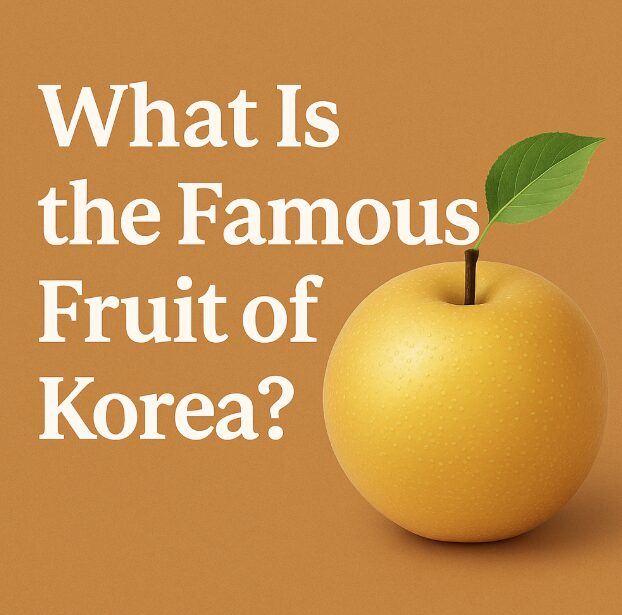When you think of Korean food, images of kimchi, barbecue, and spicy stews might come to mind. But South Korea is also home to a surprisingly rich fruit culture — from crisp fall pears to juicy summer peaches, and rare citrus grown only on Jeju Island. Among them, one fruit stands out as the most iconic: the Korean pear.
In this post, we’ll explore the famous fruits of Korea, focusing on the unique Korean pear and other seasonal favorites that are deeply tied to Korean cuisine, holidays, and regional identity. Whether you’re visiting Korea or just curious about Korean agriculture and food culture, this guide will help you appreciate the sweet side of the country.

The Most Famous Fruit of Korea: The Korean Pear (배 – Bae)
The Korean pear is unlike any other pear you’ve likely encountered. Known locally as bae (배), it’s large, round, and crisp — often mistaken for an apple at first glance.
What Makes Korean Pears Special?
Shape and Size: Typically round and apple-sized, with smooth golden skin
Texture: Incredibly crunchy and juicy, with a light, refreshing sweetness
Flavor: Mild and clean, less sugary than Western pears
Shelf Life: Keeps well when refrigerated, making it ideal for gifting
Cultural Use: Often given as a luxury gift during Korean holidays like Chuseok (Thanksgiving) and Seollal (Lunar New Year)
These pears are not only eaten raw but also used in traditional recipes — especially as a natural tenderizer in meat marinades like bulgogi or galbi.
Where to Find Korean Pears
Markets: Look for them in traditional markets and supermarkets from late summer to early winter
Gift Boxes: Often beautifully packaged for sale during major holidays
Exported Worldwide: Korean pears are now available in the U.S., Canada, and parts of Southeast Asia, especially in Korean grocery stores
Seasonal Fruits You Must Try in Korea
Korea’s distinct four seasons give rise to a variety of fruits, many of which are available only for a few weeks each year. Here’s what to look for based on the season.
Spring: Strawberries (딸기 – Ttalgi)
Peak season: January to April
Korean strawberries are known for being extra sweet and aromatic, especially varieties like Maehyang and Seolhyang
Commonly used in desserts like strawberry milk, shaved ice (bingsu), or sold in beautifully arranged boxes as gifts
Strawberry picking is a popular spring activity, especially in Gyeonggi-do and Nonsan
Summer: Peaches and Watermelons
Peaches (복숭아 – Boksunga)
Soft, juicy, and fragrant with white or yellow flesh
Summer markets often sell entire crates from local farms in Chungcheong or Gyeongsang provinces
Koreans often peel peaches before eating for a smoother texture
Watermelons (수박 – Subak)
Often very large and juicy, with fewer seeds than Western varieties
Consumed at picnics and beaches, or blended into summer drinks
You’ll also find square or heart-shaped novelty watermelons in department stores
Autumn: Apples and Persimmons
Apples (사과 – Sagwa)
Grown primarily in the Daegu region (especially in Apsan and Gyeongsangbuk-do)
Korean apples are crisp, large, and sweet — typically gifted during Chuseok in beautifully wrapped boxes
Persimmons (감 – Gam)
Available in two forms: sweet and crunchy (Fuyu type) or soft and drying-prone (Hachiya type)
Dried persimmons (gotgam) are a traditional Korean snack and also used in tea
Look for persimmon trees in rural areas in October and November
Winter: Jeju Tangerines (제주 감귤 – Gamgyul)
Grown only on Jeju Island, these tangerines are a winter staple in Korea
Small, easy to peel, and intensely sweet
Markets overflow with fresh citrus from December to February
Jeju also produces hallabong (a larger, bump-headed citrus) and cheonhaehyang, a premium hybrid variety with floral notes
How Fruits Are Used in Korean Culture and Cuisine
Korean fruits are not just for snacking — they play a variety of roles across everyday life and holiday traditions.
Holiday Gifts: Fruits are considered premium gifts, especially in the form of luxury gift boxes with large pears, apples, or citrus. These are common during Chuseok and Seollal.
Temple Food: Fruits are key ingredients in Buddhist vegetarian meals, often served fresh or as part of traditional Korean sweets
Marinades: Pears and apples are used to add natural sweetness and enzyme-based tenderness to Korean BBQ marinades
Traditional Sweets: Dried persimmons, chestnuts, jujubes, and pine nuts are used in Korean rice cakes (tteok)
Fruit-Based Drinks: Korean plum extract (maesil), citron tea (yuja-cha), and fruit vinegars are common at health shops and cafes
Fruits also appear in ancestral rituals (jesa), where they are arranged neatly on a ceremonial table as an offering.
Where to Experience Korean Fruit Culture
If you’re traveling in Korea and want to experience the fruit culture firsthand, here are some suggestions:
Visit a Local Market: Namdaemun, Gwangjang, and Dongdaemun in Seoul are great places to sample and buy seasonal fruits
Go Fruit Picking: Strawberry farms in spring, peach orchards in summer, apple farms in fall — many allow visitors to pick their own for a small fee
Try Seasonal Cafes: Trendy cafes often update their menus with fruit-based drinks and desserts depending on the season
Take Home Fruit Snacks: Packaged dried fruit, teas, or jams made from local produce are lightweight, travel-friendly souvenirs
Korean Fruits Reflect the Country’s Seasonality and Aesthetic
From the crisp perfection of the Korean pear to the vibrant sweetness of Jeju citrus, fruits in Korea are more than just food — they are part of the cultural rhythm. They represent hospitality, care, and beauty. They reflect the Korean emphasis on balance and seasonality. And above all, they are deeply tied to daily life and special occasions alike.
Next time you travel to Korea or visit a Korean supermarket abroad, pay attention to the fruits on display — their taste will tell you what season it is, and their presentation will show you how much thought and tradition goes into even the simplest things in Korean culture.